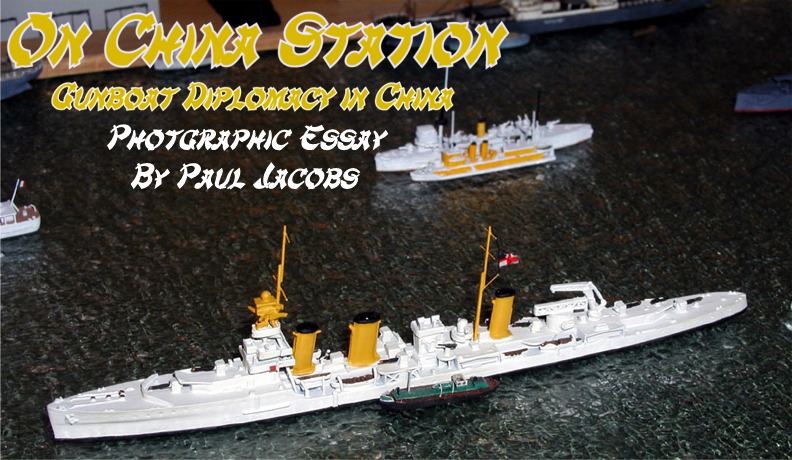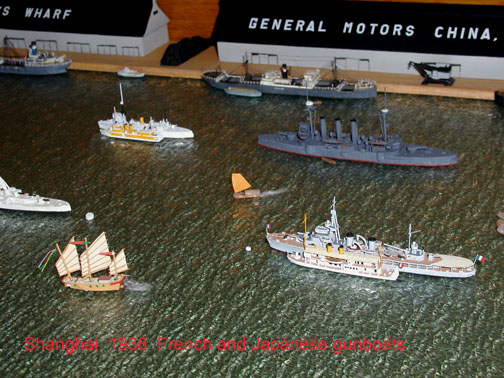 |
 |
During the 19th Century the European powers and the United States opened up Chinese ports to foreign trade, and the Europeans forced the Chinese to make concessions of Chinese land to them. These intrusions by Europeans began as early as 1840 and continued sporadically until 1900. The Chinese repeatedly tried to prevent this, with the result that there were a number of small wars, in each of which Chinese naval power was immobilized or destroyed and Chinese armies defeated. By 1900, all the major powers either had possession of Chinese ports, such as Hong Kong, Wei Hai Wei, and Tsingtau, or had concessions in ports like Canton and Shanghai. In order to protect their interests in China, the European powers maintained warships in various places in the Far East and a number were stationed in Chinese ports. The United States, having an interest in trade with China, as well as possession of the Philippines, maintained a squadron there as well.
Located at the mouth of China’s major water route to the interior, the Yangtze River, is Shanghai, China’s major commercial port. In order to travel up river to concessions inland, small vessels of shallow draft were needed. Thus were born a class of ships known as China gunboats. Generally the purpose of these ships was to "show the flag." These vessels were also intended to fight pirates and protect foreign owned vessels along the rivers. This photo essay features models of such vessels, as well as other small gunboat types that were common to the Europeans, Japanese and Americans in Chinese waters.
Among the earliest of such vessels in the late 19th century was the U.S. gunboat MONOCACY, a so-called "double-ender" built for use in the American Civil War. This vessel had a very long life on the China station, serving from 1868 to1903. Pictured here is the Langton model of SASSACUS, which has been modified to represent MONOCACY as she looked in the 1880's. MONOCACY was replaced by a built for the purpose gunboat of the same name, along with a sister ship PALOS. These two vessels served into the 1930's and were typical of China gunboats of the time. Flat bottomed, they had very shallow draft and could operate year round in the lowest of water, a necessity given the enormous changes in water levels of the Yangtze.
During the late 1920's the U.S. replaced some of its earlier gunboats with the six ships of the OAHU, PANAY, and LUZON classes. All six ships were similar in appearance but were built in three groups of two ships each, in different lengths. PANAY was sunk in 1937, by Japanese bombing. MINDANAO, LUZON and OAHU were lost in the Philippines in 1942. WAKE was captured by the Japanese at Shanghai and TUTUILA escaped up river to Chunking where she was turned over to the Chinese. Also pictured here is the gunboat ISABEL, which served as a flagship in Chinese waters, and the TULSA, which served along with others of her type in China.
The British also operated gunboats in China. The INSECT class were built for use on the Danube during WW I, but proved to be very useful between the wars serving in China. These twin funneled boats were flat bottomed and thus could operate in very shallow water. So a number of them served in that capacity until 1940. While the usual armament for a China gunboat ranged from .30 cal machine guns to 3 and 4 inch guns, these boats mounted 6 inch guns, which made them the heaviest armed gunboats on the China station.
Between the wars a number of other gunboats were built by Britain for service on the China station, including GANNET and sister, PETEREL, and the four ships of the DRAGONFLY class. Most of these vessels left China before the Pacific War began, due to the outbreak of war in Europe and the Mediterranean. However, PETEREL was sunk at Shanghai and GANNET turned over to China, while DRAGONFLY and sister, GRASSHOPPER, were sunk by the Japanese in the Indies. MOTH, of the INSECT Class, was captured by the Japanese.
The German military presence in China came later than the other great powers. Starting in the late 1890's the Germans began operating a number of gunboats in China. These included the SHAMIEN and VORWARTS, former Chinese passenger vessels, acquired around 1900, but replaced before WW I , the purpose built sisters TSINGTAU and VATERLAND, and the OTTER which was the last one commissioned, in 1912. TSINGTAU was blown up in 1917 to prevent it from falling into Chinese hands, when China entered WW I, but OTTER and VATERLAND were both captured by the Chinese, and served later in their navy. In addition, the Germans operated gunboats of the ILTIS and PANTHER Classes in Chinese waters. These were not river gunboats, however. Four of them, ILTIS, JAGUAR, TIGER and LUCHS were all lost in the Japanese siege of Tsingtau in 1914.
The French also operated river gunboats in China, as well as in Indochina to the south. Among those operated were the DOUDART DE LAGREE, and her near sister BALNY, the sisters ARGUS and VIGILANTE, and the FRANCIS GARNIER. In addition, they operated several sloops such as MARNE and TAHURE, as well as vessels of the AMIRAL CHARNER Class. Most of their river gunboats were lost during the war, or turned over to the Chinese.
The Japanese presence in China was made felt not only by river gunboats, but many other warships, the numbers of which increased significantly during the 1930's and especially after 1937. They had a number of built for the purpose river gunboats such as the HIRA Class, ATAKA, FUSHIMI, FUTAMI and ATAMI. Some of these vessels survived the war, and ended up in the Chinese Navy.
The Italians also maintained several gunboats in China right into WW II. Their last one, ERMANNO CARLOTO was captured by the Japanese. The Russians maintained a significant presence for a few years after they took over Port Arthur in 1895. But after they were ejected by the Japanese in 1904-5, they withdrew from further naval activity in China. The Soviets, who followed after 1917, professed to be anti-imperialist and opposed the presence of foreign military and commercial interests in China. The Germans, ejected from China during WW I, nevertheless maintained commercial interests in China, and while they held no concessions or territory there, it was common for German warships to visit during the 1920's and 1930's.
Generally the great powers also stationed large warships in China. Before WW I pre-dreadnoughts were common, as well as all types of cruisers. In the 1920's and 30's the major powers, generally had several cruisers each, destroyers, submarines and various auxiliary vessels stationed there. The British also stationed their smaller aircraft carriers, HERMES and EAGLE, there at various times.
It was common during the 20's and 30's for a variety of other warships to be used on the upper Yangtze; minesweepers, and destroyers for example frequently made their way up river to Nanking or further. Foreign warships typically congregated in the major ports, especially Hong Kong and Shanghai. The British generally summered their ships at Wei Hai Wei in the north, and wintered in Hong Kong, where they were often joined by warships of other foreign powers.
Life on these ships was colorful, but also fraught with danger. The Yangtze was wild and unpredictable in many parts, and ships could be driven ashore or smashed to pieces in some of the towering gorges. Pirates posed a frequent danger, as did revolution. There were a number of times during the 1920's, especially in 1927, when foreign ships found themselves under serious attack.
In the late 30's when the Japanese invaded China, the non-belligerents found themselves caught in between. It was an unpleasant situation. The Americans and Europeans continued to maintain a presence in China as best they could. European warships were often found at Shanghai, and sometimes were under fire, or threatened by near misses. After the war in Europe began in 1939, the British and French gradually removed most of their forces from China, leaving only a few vessels to show the flag. As the foreign presence waned, the Japanese grew more strident, imposing control over movement of foreign warships in Chinese waters. And by late 1941, with war looming in the Pacific, nearly all the U.S. presence had gone also.
 |
When the war ended, the British and Americans attempted to reassert their power. But the world had changed forever. Within a few years, the Chinese Communists had driven out the Nationalists, and as they swept across the country, they drove the foreigners out as well. The story of the British frigate AMETHYST which was trapped up river, and had to run the gauntlet of fire from the Communist Chinese in order to escape from the Yangtze in 1949, brought a gallant close to the history of foreign intervention in China. She was the last foreign warship to be in Chinese inland waters without permission of the Chinese government.
For more information about the ships and the men who served in them, the following books are suggested reading:
THE SAND PEBBLES (Fiction), Richard McKenna, Harper & Row, 1962.
GUNBOATS AND MARINES, Bernard Cole, University of Delaware Press, 1983.
FAR CHINA STATION, Robert E. Johnson, Naval Institute Press, 1979.
THE ROYAL NAVY AND THE SINO-JAPANESE INCIDENT 1937-41, Martin H. Brice, Ian Allan, 1973.
YANGTZE PATROL, Kemp Tolley, Naval Institute Press, 1971.
LES CANONNIERES DE CHINE 1900-1945, Bernard Estival, Marines Editions, 1994.
HOSTAGE ON THE YANGTZE, Malcolm H. Murfett, Naval Institute Press, 1991.